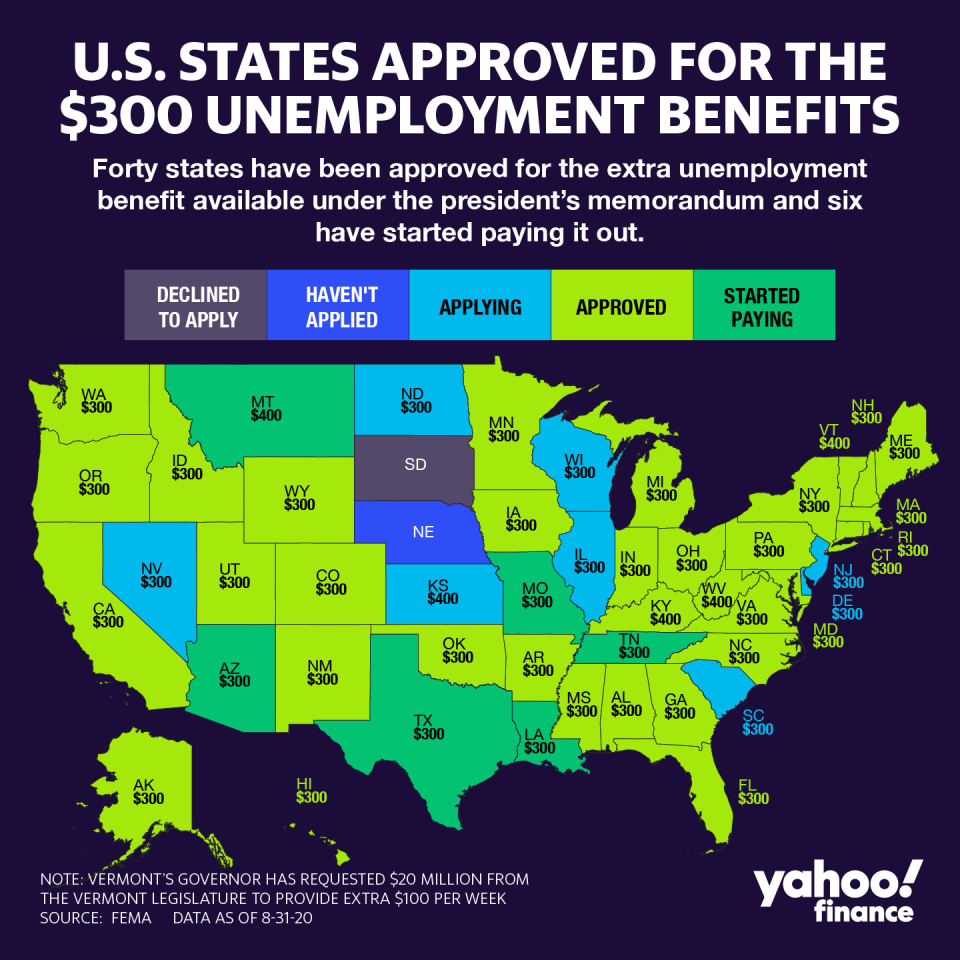Coronavirus stimulus: Six states begin paying out $300 in extra unemployment benefits
This article is updated daily.
Forty-eight states are in the process of implementing a presidential memo that provides an extra $300 to $400 of weekly jobless benefits, but only six states have begun paying out the additional money.
Arizona, Louisiana, Missouri, Montana, Tennessee, and Texas have started paying the benefit. But most states won’t begin until the end of September. After states get approved for funding, “it can take several weeks” for the extra benefit to be distributed, according to Michele Evermore, a senior policy analyst at the National Employment Law Project.
“If it was an act of Congress, they could just use their regular system to pay these benefits,” she said. But with the memorandum, “they have to set up a benefit that's parallel to unemployment insurance.”

Maryland, which was approved for extra unemployment benefits under the LWA program on Aug. 20 aims to start distributing the benefits “by late September.” Colorado, which was approved on Aug. 19, expects to start paying out the benefits “mid- to late-September.”
“States are really trying to expedite this money,” Evermore said. “Even the states that ordinarily are a little bit poky about getting benefits feel that this is the priority for the administration so ‘we better not embarrass the president right before an election.’”
The 27 million jobless Americans currently receiving unemployment insurance saw the extra $600 in weekly benefits under the CARES Act lapse at the end of July amid stalled negotiations over new stimulus legislation between the White House and Congressional Democrats.
Which states have been approved?

A total of 48 states are either moving forward or have already been approved for the Lost Wages Assistance (LWA) program as of Monday.
Forty states have been approved: Alaska, Alabama, Arizona, Arkansas, California, Colorado, Connecticut, Florida, Georgia, Hawaii, Idaho, Indiana, Iowa, Kentucky, Louisiana, Maine, Maryland, Massachusetts, Michigan, Minnesota, Mississippi, Missouri, Montana, New Hampshire, New Mexico, New York, North Carolina, Ohio, Oklahoma, Oregon, Pennsylvania, Rhode Island, Tennessee, Texas, Utah, Vermont, Virginia, Washington, West Virginia, and Wyoming.
Another eight states — Delaware, Illinois, Kansas, Nevada, New Jersey, North Dakota, South Carolina, and Wisconsin — have either signaled they’ll apply or have already applied for the additional benefits.
Read more: Here’s what you need to know about unemployment benefits eligibility
Kansas, Kentucky, Montana, and West Virginia are the only states that plan to pay the full $400. Vermont’s governor has requested $20 million in funding from the Vermont Legislature to provide an extra $100 a week, bringing the total benefit to $400, a spokesperson from the governor’s office told Yahoo Money.
Under the memorandum the president signed on Aug. 8, the federal government would provide $300 in benefits, while the state could choose to offer another $100. But the majority of states — operating under strained budgets — are opting for $300 a week as a cheaper and less complex one to administer.
South Dakota so far is the only state to decline the extra $300 altogether — meaning jobless South Dakotans will continue to receive only their regular state benefit. Nebraska and the District of Columbia have yet to apply or decline to apply for the benefit.
“People have different views of the unemployed in different parts of the country,” Andrew Stettner, an unemployment insurance expert and senior fellow at the Century Foundation, a think tank told Yahoo Money last week. “You don't have a guarantee of this aid, depending on where you live.”
Who is ineligible this time?

Jobless Americans also need to earn at least $100 to get the extra benefits provided by the executive memo, a requirement that didn’t exist under the CARES Act.
People making under $100 per week account for 6% of unemployment insurance (UI) recipients, according to Eliza Forsythe, a labor economist, and professor at the University of Illinois.
Women would be disproportionately affected by the minimum threshold, accounting for 70% of those workers who earn less than $100 a week. Female workers also saw some of the biggest reductions in income after the additional $600 expired, because the benefits accounted for a larger part of their income.
“It leaves out the poorest recipients,” said Gbenga Ajilore, a senior economist at the Center for American Progress, a nonprofit for public policy research and advocacy, told Yahoo Money earlier this month. “This is needlessly cruel because they are already struggling and it increases the difficulty for states to implement the program.”
How long will the benefits last?
Initially, experts expected the benefits to last around five weeks, but under the latest guidance from the Federal Emergency Management Agency (FEMA), jobless Americans are guaranteed the extra $300 for only three weeks.
States must apply for the additional unemployment benefits first. When approved, they “will receive an initial obligation of three weeks of needed funding,” according to the FEMA guidelines. Any extra after that will be decided on a week-by-week basis until the funds deplete.
The FEMA funds are not just for funding the unemployment benefits; they also fund disaster relief, meaning they could run out sooner than expected.
“It all depends on whether or not there's enough money in the disaster relief fund,” Evermore said.
Denitsa is a writer for Yahoo Finance and Cashay, a new personal finance website. Follow her on Twitter @denitsa_tsekova.
Read more:
Analysis: 1 in 3 jobless Americans could be left out of Trump's action on unemployment
Even as GDP tanked, personal income grew thanks to government support
Read more personal finance information, news, and tips on Cashay
Follow Yahoo Finance on Twitter, Facebook, Instagram, Flipboard, SmartNews, LinkedIn, YouTube, and Reddit.

 money
money 

